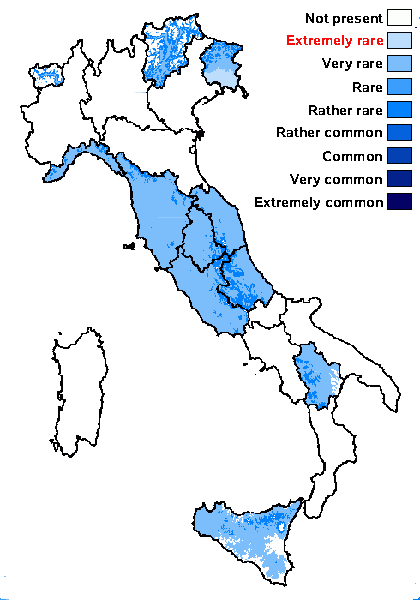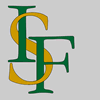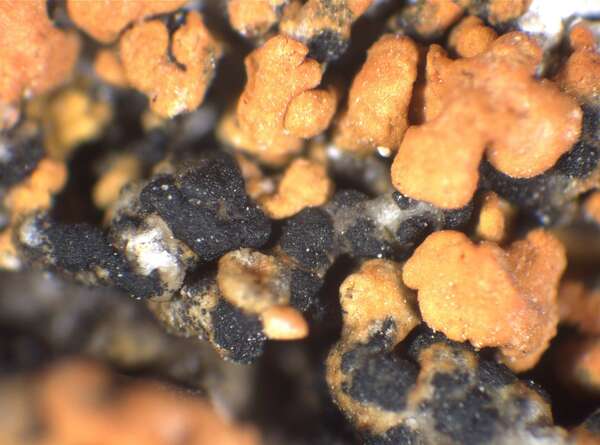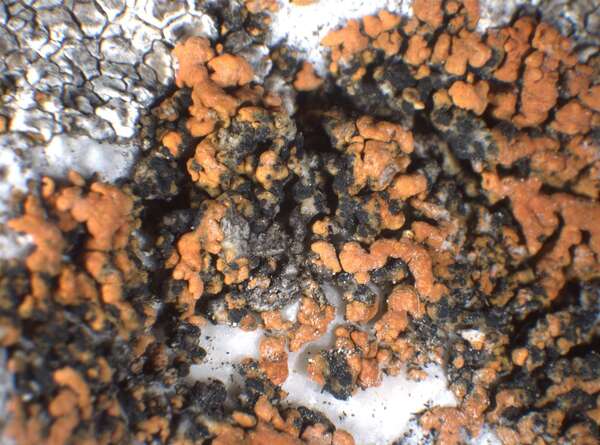Arthonia molendoi (Frauenf.) R. Sant.
Thunbergia, 3: 2, 1986. Basionym: Tichothecium molendoi Frauenf. - in Arnold, Verh. zool. bot. Ges. Wien, 14: 461, 1864.
Synonyms: Arthonia molendoi (Arnold) R. Sant.; Bryostigma molendoi (Heufl. ex Arnold) S. Y. Kondr. & J.-S. Hur
Distribution: N - Frl (TSB 5100 as A. clemens), TAA (Nimis & Tretiach 1999, Brackel 2008, 2011, 2015, 2016), VA (Hafellner 2021), Lig (Ravera & al. 2022). C - Tosc (Herb. von Brackel 393), Marc (Herb. von Brackel 390), Umb (Herb. von Brackel 394), Laz (Herb- von Brackel 389), Abr (Nimis & Tretiach 1999, Brackel 2015, 2016, 2020). S - Bas (Brackel 2016, 2020), Si (Herb. von Brackel 392).
Description: Thallus inapparent, not lichenized, the hyphae developing inside the thalli of crustose and foliose Teloschistaceae. Apothecia arthonioid, immarginate, single or in groups of up to 5(-10) per infection spot, sometimes coalescent, developing in the cortex of the host, more or less round, adnate, 0.1-0.3 mm across, with a jet black, convex disc, without a proper margin. Proper exciple poorly developed; epithecium blackish brown with a dark olivaceous tinge, 15-20 µm high, K-; hymenium colourless to pale brown, up to 45 µm high, I+ red, K/I+ blue; paraphysoids branched and anastomosing, c. 2 µm thick, the apical cells up to 4 µm wide; hypothecium colourless to pale yellow, 50-60 µm high. Asci 4-8-spored, broadly clavate to subglobose, semi-fissitunicate, with a large, non-amyloid apical dome, and a distinct ocular chamber, Arthonia-type. Ascospores 1-septate, one cell slightly attenuated, hyaline, 8-13 x 4-6 µm, with a gelatinous epispore. Photobiont absent. Spot tests: K-, C-, KC-, P-. Chemistry: without lichen substances.
Note: a widespread, holarctic and bipolar lichenicolous fungus which in Italy is most frequent on the type host Rusavskia elegans, and on Xanthomendoza- and Calogaya-species; earlier records reported as growing on Xanthoria parietina refer to the recently-described Arthonia parietinaria (see Fleischhacker & al. 2016 and Brackel 2020).
Growth form: Lichenicolous fungus
Substrata: rocks
Reproductive strategy: mainly sexual
paras Xanthoria spp. and Caloplaca s.lat. spp.
Commonnes-rarity: (info)
Alpine belt: absent
Subalpine belt: very rare
Oromediterranean belt: absent
Montane belt: rather rare
Submediterranean belt: very rare
Padanian area: extremely rare
Humid submediterranean belt: very rare
Humid mediterranean belt: very rare
Dry mediterranean belt: absent

Predictive model
Herbarium samples
Growth form: Lichenicolous fungus
Substrata: rocks
Reproductive strategy: mainly sexual
paras Xanthoria spp. and Caloplaca s.lat. spp.
Commonnes-rarity: (info)
Alpine belt: absent
Subalpine belt: very rare
Oromediterranean belt: absent
Montane belt: rather rare
Submediterranean belt: very rare
Padanian area: extremely rare
Humid submediterranean belt: very rare
Humid mediterranean belt: very rare
Dry mediterranean belt: absent

Predictive model
| Herbarium samples |
 Index Fungorum
Index Fungorum
 GBIF
GBIF




